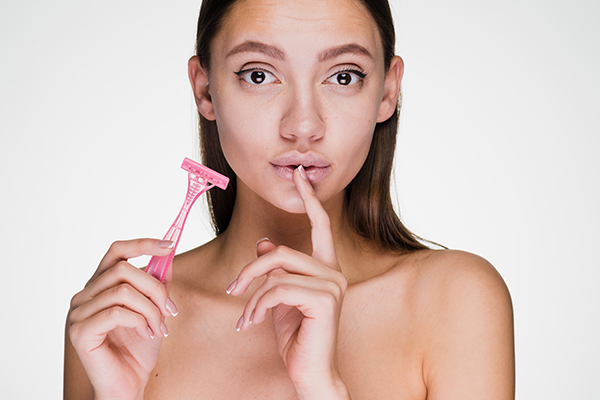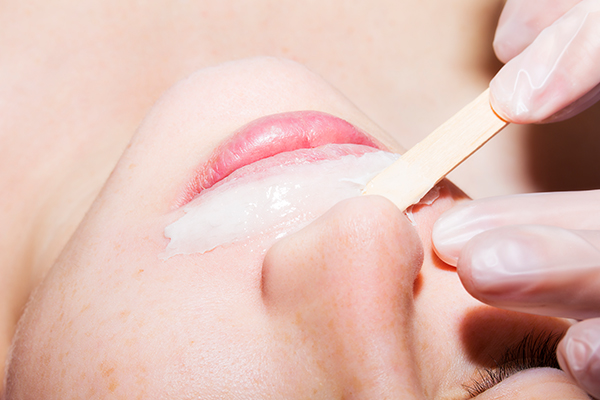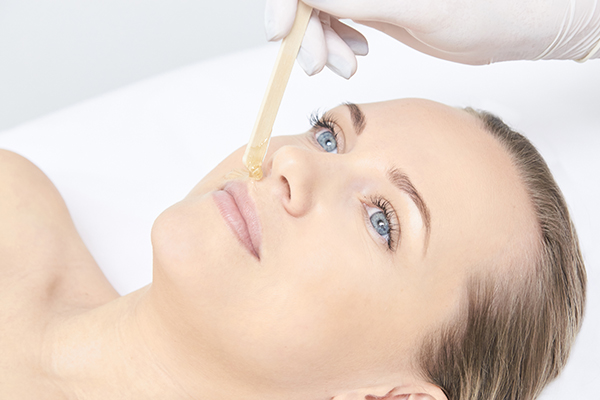In this article:
Unwanted facial hair is something most women have to deal with. Often, due to societal norms or by personal choice, this unwanted facial hair, including upper lip hair, can make women feel self-conscious about their appearance and can affect their confidence.

While it is common to have some facial hair growth that can be managed with regular shaving, threading, or waxing the hair, some women may have thicker or excessive upper lip hair growth.
In fact, 5%–10% of women have upper lip hair growth problems. (1) These problems generally occur due to hereditary factors, hormonal imbalance, or polycystic ovary syndrome.
It is a common desire among people, especially women, to have unwanted facial hair removed more effectively or even permanently. The good news is several medical and at-home treatments can manage upper lip hair growth, which will be discussed in this article.
In-Office Treatments
Consult your dermatologist for medical treatments that can reduce unwanted facial hair growth or even remove it permanently. Here are the most common options.
1. Laser treatment

Laser treatment is one of the most common and effective methods to permanently reduce upper lip hair. (2) It involves the use of thermal energy and targeting a concentrated light beam on the hair root to destroy it within the follicle.
While laser treatment is costly, it results in permanent hair reduction after a few sessions, therefore eliminating the cost of any further hair removal procedures.
Each session reduces hair shaft thickness and overall density, and a 20% reduction in hair growth is expected each session. Several sessions can delay hair growth for 2–3 months. Moreover, laser treatment is painless and leaves your skin smooth.
2. Dermaplaning
Dermaplaning is a type of shaving that is best performed by a professional. It involves the use of a sharp scalpel to remove the hair and also to increase skin cell turnover. (3) This procedure also exfoliates the skin by removing dead skin cells on the surface, removes peach fuzz, and helps reduce wrinkles.
Dermaplaning can be used as a nonpainful but temporary method of hair removal. It is more effective and thorough than simple shaving.
At-Home Treatments
Removing upper lip hair at home is a common practice and can be performed in various ways. Always conduct a patch test before trying a new method of removing upper lip hair.
Here are some common hair removal methods that you can try at home.
1. Shaving

Shaving unwanted hair by using a razor is one of the simplest and pain-free hair removal methods you can perform at home.
Directions:
- Use shaving cream on the target area.
- Pull the upper lip down to keep the skin taut.
- Use a sharp razor and shave in the direction of the hair growth. Use short strokes to prevent cuts. Avoid shaving areas with open wounds or spots.
2. Threading
Threading is another common hair removal method that can be performed at home or in salons.
Threading involves rolling doubled and twisted cotton threads over the upper lip area to pull out the hair from the follicles. This procedure is often painful and may cause skin redness. However, threading is a hygienic hair removal method that can keep the area free of unwanted facial hair for up to 3 weeks. (4)
3. Waxing
Waxing is a quick and easy hair removal method that not only pulls out the hair from the roots but also clears your skin of dead skin cells and dirt. (5) This method, similar to threading, is also painful and may cause redness if your skin is sensitive.
Note: Upper lip waxing is not commonly advised as it can be a bit too harsh.
Directions:
- Heat some facial wax and apply it over your upper lip area, one side at a time.
- Place a wax strip over the wax. You can also apply ready-to-use facial wax strips.
- Once the wax is cool, pull the wax strip in the direction opposite to the hair growth.
4. Tweezing
You can easily remove your upper lip hair by using tweezers. However, it is best to use tweezers to pull out tiny hair strands, as tweezing out full-grown hair, one by one, can be very painful.
You can tweeze out any hair that has a long-enough shaft that can be gripped. Tweezing your hair prevents hair growth for up to 3 weeks. It is a fairly inexpensive hair removal method as it requires only a pair of tweezers and a hand mirror, which can be used for years.
5. Depilatory creams

Depilatory creams are a quick and easy solution to unwanted hair growth. The cream helps dissolve the surface hair, enabling easy removal. However, the effect only lasts for up to 3 days. In addition, depilatory creams contain chemicals, and therefore, their frequent use may be harmful to your skin.
Directions:
- Apply the cream to your upper lip area.
- Leave it on for the time specified in the instructions.
- Remove the cream using the provided spatula.
6. Epilator
An epilator is a device containing rotating tweezers or discs that pull out hair from the follicle pores. The mechanism is similar to tweezing; however, instead of removing one hair at a time, the epilator can remove a bunch of hair together.
Directions:
- Exfoliate your skin using a facial scrub.
- Run the epilator over the target area.
7. Sugaring

Sugaring is a process similar to waxing that pulls out hair from the roots. It uses a sticky paste made of sugar that sticks to your hair shaft, pulling it out when you pull the paste. However, this method is less painful than waxing.
Directions:
- Mix ½ cup of sugar, 2 tbsp of water, and ½ cup of lemon juice.
- Boil the mixture until the color becomes amber.
- Allow the paste to cool for about 45 minutes. The mixture will form a toffee-like consistency, which can then be balled up.
- Use this sugar paste ball and stretch it over your skin surface, in the direction opposite to your hair growth.
- Pull off the paste, removing the hair with it.
Final Word
Upper lip hair is a common presentation – it can be a few thin strands or a fuller mustache-like appearance. To some people, this unwanted hair can be bothersome.
There are various hair removal methods that can remove unwanted hair in the upper lip area permanently or temporarily. If you use at-home hair removal methods, you may need to repeat the procedure every few weeks. If you are looking for a permanent solution, consult your dermatologist.
- Was this article helpful?
- YES, THANKS!NOT REALLY


